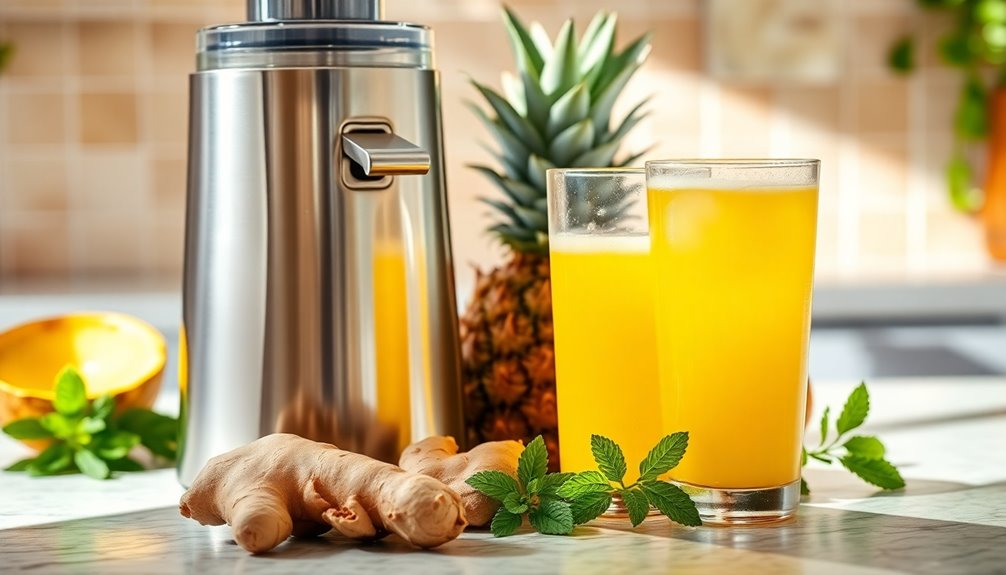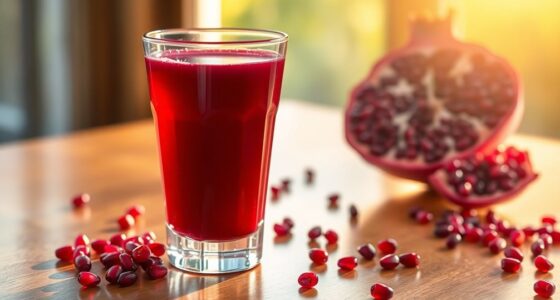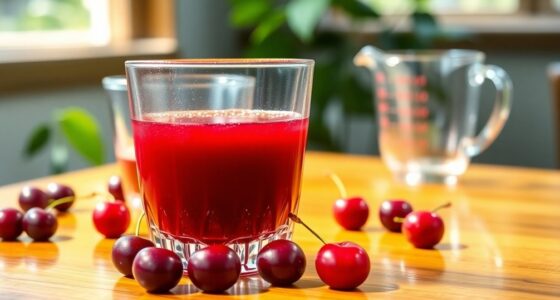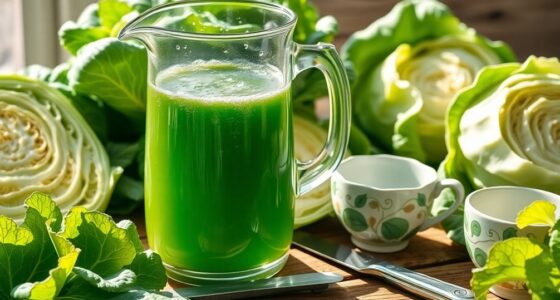To make pineapple ginger juice, start by peeling and chopping 2 pounds of ripe pineapple and 50 grams of fresh ginger. Blend them with 1 cup of water until smooth. Strain the mixture to separate the juice from the pulp, yielding about 24 ounces. Enhance the flavor with the juice of one lime, and consider adding turmeric, cucumber, or mint for extra zing. This drink's refreshing and healthy, and there's more to discover about it!
Key Takeaways
- Peel and chop 2 pounds of ripe pineapple and 50 grams of fresh ginger before blending for a smooth mixture.
- Blend the pineapple and ginger with 1 cup of water until smooth, creating a silky base for the juice.
- Strain the blended mixture using a fine mesh strainer to separate the juice from the pulp, yielding about 24 ounces.
- Enhance flavor by adding the juice of one fresh lime and optional ingredients like turmeric, cucumber, or mint.
- Store the juice in the refrigerator for 3-4 days, shaking well before serving to mix settled ingredients.
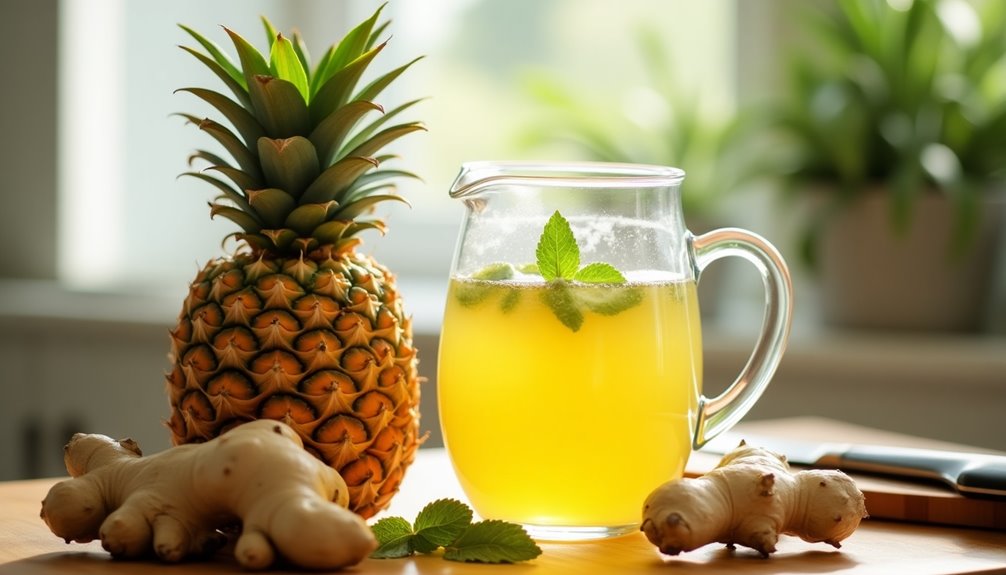
If you're looking for a refreshing drink that packs a flavorful punch, making Pineapple Ginger Juice is a fantastic choice. This juice isn't just delicious; it's also loaded with health benefits. The combination of pineapple and ginger provides a boost to your immune system, making it a great option for those wanting to stay healthy while enjoying a tasty beverage. Plus, using fresh ingredients ensures you get the maximum flavor and nutrients.
To start off, you'll want to gather your ingredients. You'll need about 2 pounds of ripe pineapple and 50 grams of fresh ginger. The freshness of these ingredients is key to achieving that vibrant taste you're after.
Begin by peeling and chopping the pineapple into small chunks. Don't forget to peel the ginger as well, since the skin can add a bitter flavor to your juice. Now that you've got everything prepped, it's time to blend the pineapple.
In a blender, combine the chopped pineapple with the fresh ginger and add a little water—about a cup should do. This will help the blender do its job more efficiently. Blend the mixture until it's smooth, making sure you break down all the fibrous bits of the pineapple and ginger. The goal here is to create a silky base for your juice.
Once the blending is done, it's time to strain the blended mixture. Using a fine mesh strainer or a nut milk bag, strain the blended mixture into a bowl or jug. This separates the juice from the pulp, giving you a clear and refreshing drink. You should yield approximately 24 ounces of juice, perfect for sharing or enjoying throughout the day.
To elevate the flavor profile, squeeze the juice of one fresh lime into the strained juice. Lime not only adds a zesty kick but also infuses additional nutrients into your drink. Stir well before serving to make sure everything is combined.
Now that you've got your Pineapple Ginger Juice ready, you might want to consider how to store it. For optimal freshness, keep the juice in the refrigerator. It'll stay good for about 3-4 days. Just be sure to give it a good shake or stir before serving, as it may settle over time.
If you're feeling adventurous, you can also enhance the juice with other flavors. Adding a little turmeric can give it an earthy depth, while cucumber adds a refreshing twist. Mint can also provide a cooling effect, making your juice even more invigorating. Additionally, incorporating chia seeds into your juice can provide a boost in dietary fiber, supporting your digestive health.
Frequently Asked Questions
What Does Pineapple and Ginger Juice Do to the Body?
Pineapple and ginger juice offers numerous benefits for your body. It boosts your immune system with a hefty dose of vitamin C, helping you fend off illnesses.
The bromelain in pineapple aids digestion and may reduce inflammation, while ginger's anti-inflammatory properties enhance circulation and alleviate pain.
This juice also combats oxidative stress, lowering your risk of chronic diseases, and supports digestive health by easing nausea, making it a great addition to your wellness routine.
How to Make Ginger Drink With Pineapple?
To make a delicious ginger drink with pineapple, you'll start by peeling and chopping fresh pineapple and ginger.
Blend them together with some water until smooth, then strain the mixture to separate the juice from the pulp.
For extra zing, squeeze in fresh lime juice.
If you want to get creative, consider adding turmeric or mint.
Store your drink in the fridge for a refreshing treat that lasts a few days!
How Long Can Pineapple and Ginger Juice Last in the Fridge?
You might think freshly made juice lasts forever, but that's not the case.
Pineapple and ginger juice can stay fresh in your fridge for about 3-4 days. To get the best flavor and nutritional benefits, try to drink it within 1-2 days.
If you notice separation, just give it a stir or a shake before serving.
For longer storage, freeze it in ice cube trays, where it'll last up to 3 months!
How to Make Pineapple Juice at Home?
To make pineapple juice at home, you'll need a ripe pineapple.
Start by peeling, coring, and chopping it into chunks. Blend the pineapple pieces with a bit of water until smooth.
If you want a clearer juice, strain the mixture through a fine mesh strainer. You can sweeten it with a little sugar or honey if desired.
Chill the juice in the fridge before serving for a refreshing drink. Enjoy!
Conclusion
In conclusion, making pineapple ginger juice is not only refreshing but also packed with health benefits. Did you know that ginger can help boost your immune system by up to 40%? So, as you enjoy this delicious drink, you're also giving your body a natural defense against illness. The sweet and spicy combination is sure to invigorate your taste buds while promoting wellness. Grab your ingredients and enjoy this vibrant juice today!
Cindy thoroughly researches juicing trends, techniques, and recipes to provide readers with practical advice and inspiration. Her writing style is accessible, engaging, and designed to make complex concepts easy to understand. Cindy’s dedication to promoting the advantages of juicing shines through her work, empowering readers to make positive changes in their lives through the simple act of juicing.

